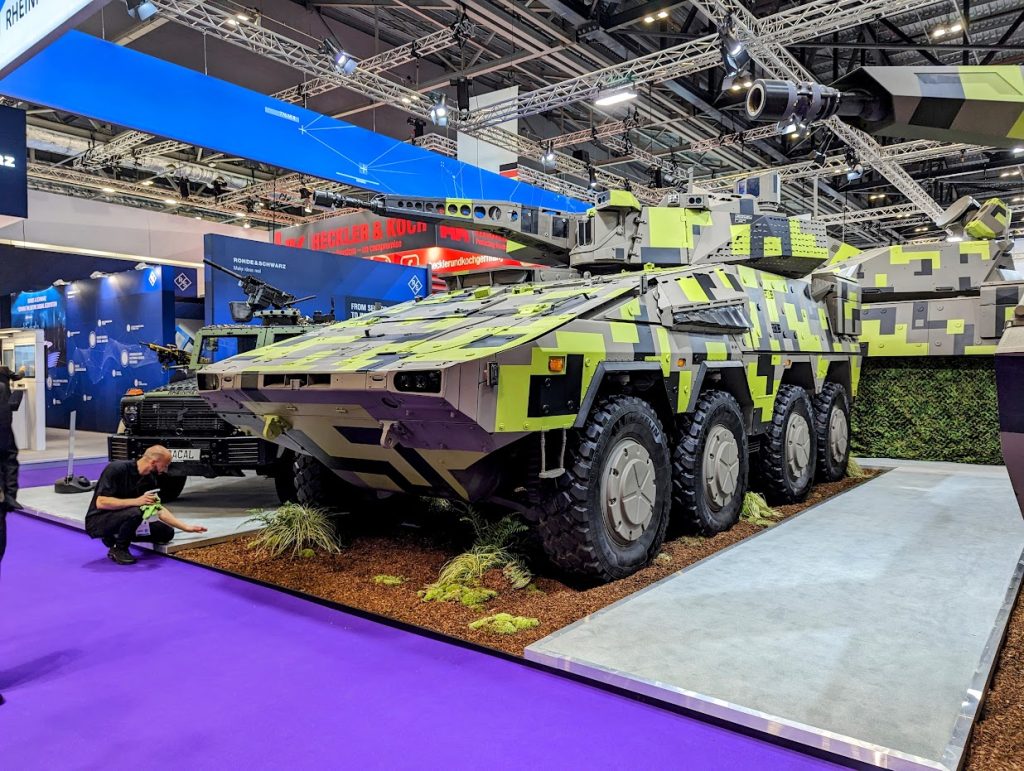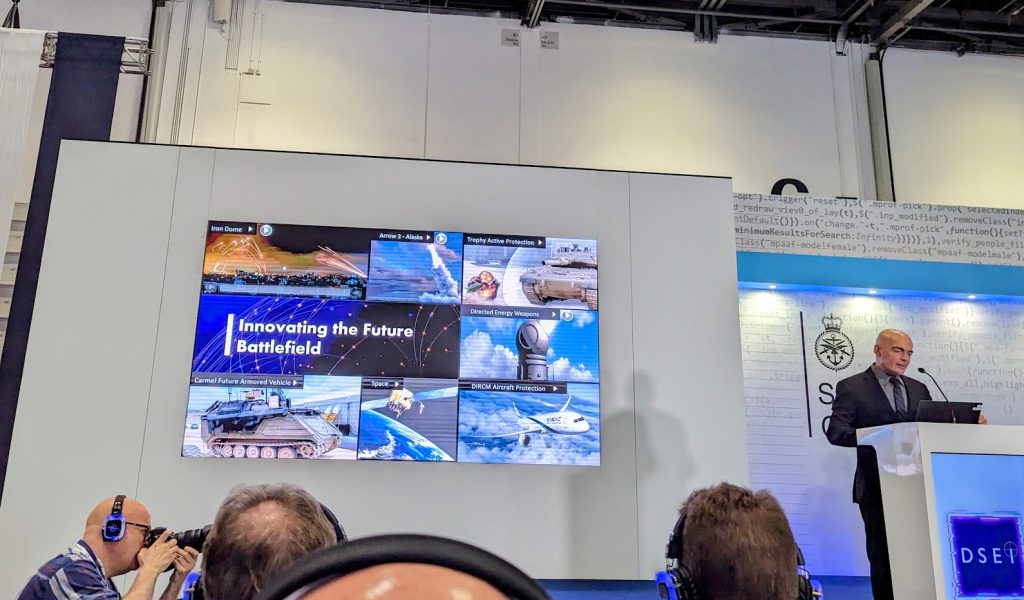DSEI (Defense & Security Equipment International) is a four-day event that showcases defense hardware and military technology, taking place once every two years.
With over 1,500 suppliers and taking over the entirety of London’s ExCel, it is the world’s largest defense and security show.
Among exhibits from BAE Systems, MBDA, Leonardo, and Lockheed Martin, I found several companies using 3D printing, including one that has developed its own 3D printing process for ceramics. DSEI 2023 also featured numerous conference tracks, with additive manufacturing in the spotlight on day one via a Manufacturing Technology Centre (MTC) led panel entitled Additive manufacture at point of use: Challenges and opportunities.
The event is unlike others I attend, most notably in the level of security before entering. Fortunately, the endless checkpoints, scanning arches, bag searches, sniffer dogs, and the combined vigilance of the London Met and ExCel security team prevented any unauthorized dangerous items from entering DSEI.

Setting the tone of the global environment for those active in this sector, General Sir Patrick Sanders, Chief of Staff British Army, suggested that “rather than thinking of ourselves as we’ve tended to do, as a post-war generation, we should contemplate what it might feel like to be a 21st century, pre-war generation.”
For some, that world is already here. As Brigadier General (res) Dr. Danny Gold, Head of DDR&D, Ministry of National Security, Israel, explained during his keynote.
The DDR&D, he explained, is not a conventional R&D hub; it’s a mammoth entity overseeing around 1,500 projects simultaneously, ranging from $100,000 university research programs to billion-dollar defense interception systems. “We are in charge of creating the technology superiority for the Ministry of Defence in Israel,” Gold said, emphasizing their roles in international cooperation, fostering innovation, and nurturing future tech leaders.
The DDR&D’s work is certainly multifaceted. Not only do they closely collaborate with major defense firms, but they also engage with about 200 startups, tapping into the innovation-rich “startup nation” ethos of Israel.
The Iron Dome, Israel’s famed missile interception system, took center stage. A brief video clip revealed the chilling reality of life near Israel’s borders – rockets aimed at children during a festival. The Iron Dome’s interception capabilities were then contrasted, showcasing the system’s real-time effectiveness in defending urban areas, such as Tel Aviv, during actual conflicts. “The system is designed to learn all the time,” Dr. Gold noted, implying a continuous improvement in efficiency and accuracy.
Dr. Gold further unveiled Israel’s multilayered defense approach. Following the Iron Dome, there’s the ‘David’s Sling’ system to thwart long-range ballistic and cruise missiles. Even higher up, the Arrow 2 system defends against medium-range ballistic missiles in the atmosphere, and above that, the Arrow 3 intercepts ballistic missiles in space. Germany’s recent decision to adopt the latter system was highlighted with a captivating visual of an Arrow 3 test conducted in the vast expanses of Alaska.
But the future, Dr. Gold divulged, is even brighter – and sharper. The integration of laser technology into Israel’s defense network is already in progress. Preliminary tests displayed the laser system’s ability to neutralize threats, whether rockets or UAVs, adding another layer to Israel’s protective umbrella.
Protecting troops on the ground isn’t neglected either. Systems like ‘Trophy’ offer tanks a protective ‘bubble’ against antitank missiles or rockets. “It’s like a micro Iron Dome,” Dr. Gold elucidated, stressing the crucial seconds in which these systems operate.

Missiles, Lasers, and AI: The Vanguard of Aerial Defence
When considering the evolving nature of aerial threats, one cannot underestimate the menace of MANPATS, Man-portable anti-tank systems. These are essentially small-to-midsize missiles, often shoulder-launched. The speaker recalled a harrowing event in Mombasa, Kenya, where terrorists narrowly missed shooting down a commercial jet. Such threats demanded a pioneering solution.
The innovation described paints a futuristic picture: once a missile targets an aircraft, the aircraft’s defense mechanism instantly releases a sophisticated laser. This isn’t a high-powered beam, but rather a system that releases what can metaphorically be described as ‘viruses’. These ‘viruses’ penetrate the missile’s head, bypassing its protective systems, much like an antivirus, redirecting it off course.
“The trick,” said the presenter, “is to miss the target.” This innovation isn’t mere conjecture but has already been operationalized in some airlines depending on the route.
Commercial Tech Integration: Harnessing the Swarm
Much has been made globally of the commercial tech boom – AI, machine learning, big data, and quantum technology. The presenter passionately argued for harnessing these resources for defense purposes. Take drones, for instance. Israel has progressed from long-endurance drones to a new generation of ‘swarming drones.’ These aren’t just surveillance tools – they’re more like an all-seeing Big Brother. They scan urban areas, track every entity, and leave no potential threat unspotted.
“We miss no terrorist, no human being, no car, no launcher,” the speaker emphasized.
The confluence of commercial technology and defense needs is clear. Yet, it’s not without challenges. Startups are agile and dynamic, but they often clash with bureaucratic systems. Israel’s response? Adapt and streamline processes, easing collaboration and fostering innovation.
Collaborating with the Startup Ecosystem
The speaker cited numerous examples of fruitful collaborations with startups. A notable one involved the development of the sophisticated laser system used to deter missile threats. Originally, this laser was aimed at high-end shipyard welding in the commercial sector. Another instance featured a nanosatellite startup, which offers a competitive alternative to Elon Musk’s broadband vision.
Addressing the startups’ agility, the speaker quipped about a unique tool developed by one – a kit that ensures marksmen hit their target on the first or second shot. This level of precision is likened to a seasoned sniper’s prowess, only this time, technology plays the marksman role.
Yet, Israel’s innovation isn’t just limited to its borders. The presenter highlighted the country’s intent to collaborate internationally, merging the might of the “startup nation” with global partners to foster mutual growth.

Subscribe to the 3D Printing Industry newsletter to keep up to date with the latest 3D printing news. You can also follow us on Twitter, like our Facebook page, and subscribe to the 3D Printing Industry Youtube channel to access more exclusive content.
Are you interested in working in the additive manufacturing industry? Visit 3D Printing Jobs to view a selection of available roles and kickstart your career.
Featured image shows DSEI 2023. Photo by Michael Petch.



